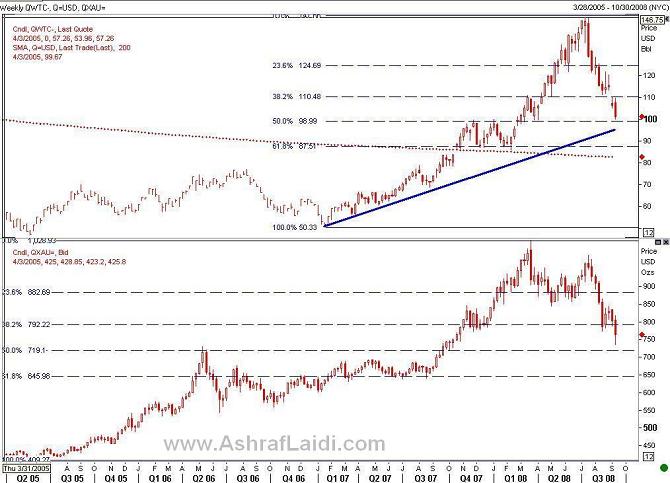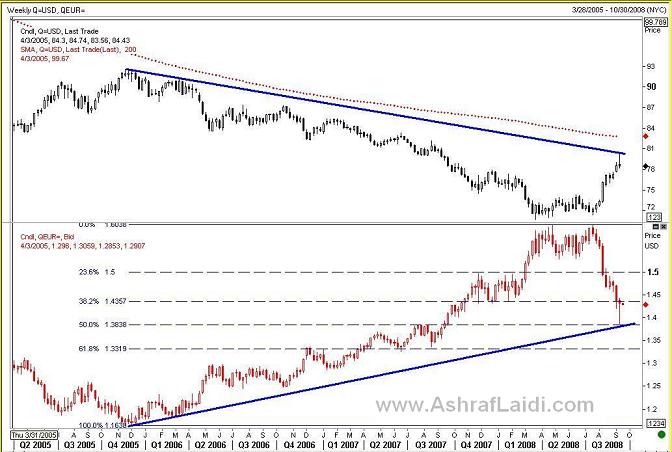Confluence for a Dollar Top? (with Charts)
Risk aversion is increasing looking like a pendulum swinging violently, with both extremes signifying heightened fear, with the lowest point of the pendulum reflecting short-lived reductions in aversion. Barclays announcement to reject the purchase of Lehman, the confirmed bankruptcy of Lehman and Merrill Lynchs announcement to sell itself to Bank of America each signified a rapid reduction in risk, which was principally guided by broad dollar declines and yen rallies. Temporary relief in volatility and risk aversion were triggered by announcements from a group of international banks forming a $50 bln fund to save help troubled banks.
Careful with FIFO Analysis on Currencies
A major fundamental argument sustaining the prior dollar rally was that of First-In-First Out (FIFO), supporting the hypothesis of the US recovering earlier than Europe because it had preceded it in entering the global slowdown and has delivered more aggressive fiscal and monetary measures than the old continent. While this notion is partially true, it overlooks the fact the impaired US banking capital and broadening credit woes (in interbank market and hedge funds) are the main factors distinguishing the US challenges from those in continental Europe. Stated differently, the Eurozone patients may have joined the global intensive care unit well after the U.S., but it in no way suggests that their condition is more critical than that of the U.S. Consequently, the collapse of Fannie/Freddie and Lehman, and near collapse of Merrill Lynch exemplify the repercussion on the increasingly fragile consumer fabric and employment foundation. The argument for Fed rate cuts is not only aimed at shoring up liquidity or inter-bank confidence, but adding from what remains of the Feds firepower to the ailing economy.
A Cut in the Discount Rate?As in August 2007, the Fed may be expected to try markets reactions with a rate cut in the discount rate rather than in the Fed funds rate to further increase banks access to the feds lending window. The discount rate currently stands 25-bps above the 2.00% Fed funds rate, half than where it was before the beginning of the easing campaign last August. At a time when the Fed has tripled the period of term loans to banks and expanded the range of loans it could buy from banks, it only makes sense to lower the discount rate down to the Fed funds level. The Fed's inflation priorities are now largely overwhelmed by their obligation to save the financial system as well as the economy.
Since June, I have been predicting that the next interest rate change will be down than up, compare to majority of pundits who had expected rate hike. Here are the articles June 27 and June 18.
Planet Alignment for a Dollar Top?
The charts below show confluence of macro forces acting to halt the dollar rally. US dollar index gives way at the 3-year trend line resistance of 80.70, while EURUSD stabilized last week at the major support of $1.3877, which is near the 3-year trend line (blue line) and 50% retracement of the rise from the $1.1638 low (Nov 2005) to the record high of $1.6036. Similarly, oil's decline has yet to breach the $98.66 support, which is the trend line support from the January 2006 low. Gold shows to have bottomed at $745, which is just above the key support of $730 support (previous resistance in May 2006) and the 50% retracement of the rise from the March 2005 low to this years fecord high.


The fundamental underpinning of these chart formations is emerging from the latest woes in Wall Street and from a possible reduction in the dollars yield foundation in the discount rate. We continue to expect 50 bps in the fed funds rate, with the most plausible scenario occurring between Tuesdays FOMC meeting and the October meeting. But we are not yet ready to pronounce the end of the dollars upward correction due to what may occur in European banks ties to Lehman as well as the macroeconomic weakness in the continent.
CHF and JPY continue to outperform across the board, especially against the wobbly USD and GBP. USDJPY seen capped at 106.20, with pressure pulling back towards 105.20 and 104.80. USDCHF eyes 1.1160, EURCHF eyes 1.5850, AUDJPY capped at 86.20, eyes 84.60 and 84.20.
|
Trader Menelau
Romania
Posted Anonymously
16 years ago
Sep 26, 2008 22:02
Insightfull
|








